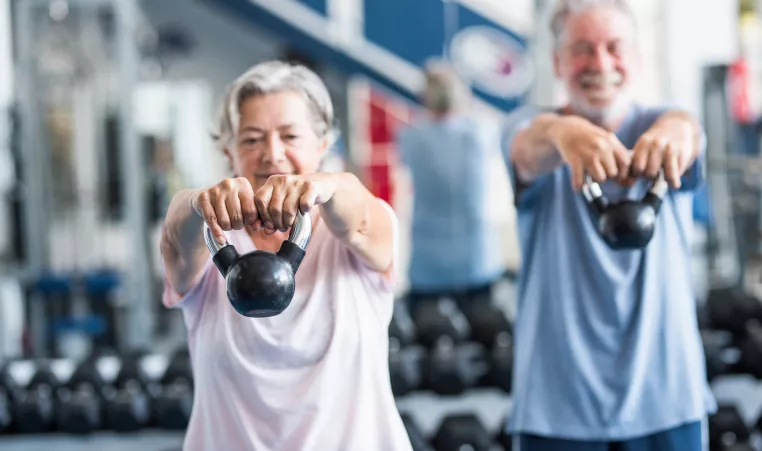
Strength Training improves quality of life for all humans but becomes increasingly important as we age. As Jill Grindstaff, Certified Personal Trainer with an M.S. in Public Health and Physical Education explained in our “Fitness for Active Older Adults” blog, 60–70-year old’s have lost around 12% of their muscle mass, this number increases to a staggering 50% at 80+. This muscle loss is mostly due to inactivity, making the old saying true, “Us it or lose it.” Joint movement also becomes stiffer and less flexible as you age because the amount of lubricating fluid inside your joints decreases while the cartilage gets thinner. Shortening of ligaments also creates stiffness and loss of flexibility.
Now you may not think much of needing to be “strong” at 60+ but we are not talking about “pushing a car” strength. When talking about muscle mass, we are not talking about body builders either. We are talking about being healthy and independent for as long as possible.
It is being able to walk for distance, climb stairs, carry groceries, and get up and down from the floor without fear. Studies show that strength training is one of the best ways to fight the weakness and frailty that can come with age. Strength training builds strong muscles and bones to preserve not only your strength but your independence, dignity, and energy.
Strength Training is safe and effective at any age, including those with health issues. In fact, people with health issues such as heart disease and arthritis often benefit the most.
We have a training client here at the Armbrust YMCA, a stroke victim, whose goal was to be able to get up from the floor on his own if he fell. His trainer Rob took him to a safe space, covering the floor with mats and they worked on it for weeks until he could do it on his own. Again, we are talking about quality of life, not being big and buff. The definition of strength is different for all of us.
Strength training can also reduce the signs and symptoms of many diseases and chronic conditions in the following ways:
• Arthritis—Reduces pain and stiffness while increasing strength and flexibility.
• Diabetes—Improvement in glycemic control.
• Osteoporosis—Builds and rebuilds bone density reducing risk for falls.
• Heart disease—Reduces cardiovascular risk by improving lipid profile and overall
fitness.
• Obesity—Increases metabolism, which helps burn more calories by burning mor
calories throughout the day helping with long-term weight control.
• Back pain—Strengthens back, hips and abdominal muscles to reduce stress on the
spine.
• Balance—Improves body control and coordination.
One of Jill’s clients Miss Lois, who is almost 75 years old, began strength training in 2013 at 65 years of age after an ankle injury. My favorite quote from Lois regarding regular strength training is, “Motion is lotion!” She shocked her doctors when she only needed crunches for the first week post knee replacement, when most need assistance walking for 3-6 weeks (about 1 and a half months) post-surgery. She also reached her goal range of motion, was able to drive herself, and get up out of a chair on her own within just two weeks, clearing her a solid month before the average patient. Studies show it can take up to three months for pain and swelling to subside, but Lois was back at the Y training with Jill inside of two months, having made to changes to her exercise selection. “Strength training changed my life. I have more energy which makes me more motivated in all areas of my life. My mental health is so much better, which is so important as I care for my husband with dementia. It makes my life so much easier not having to think about how I am going to do chores and run my errands because I can do things on my own. I just make my appointment, meet with Jill, and she takes care of me.”
My eldest client Miss Rita also began Strength Training late in life with her husband Ken. They worked out together for some eight years before Ken got sick. She was away from the gym for about three years taking care of and visiting him in hospital or rehab until he passed less than two years ago. She came to me about a year ago to help her “get back into shape.” This was music to my ears as I had never heard those words from an 80-year-old. That is correct, Miss Rita just turned 81 and still lives alone able to walk up and down stairs, get down and up from the floor, and haul 30-pound bags of dog food for Chester without needing “help out” at the grocery store. “The Y is part of my health insurance. I keep up the habit of strength training twice a week so that my children still have a parent for as long as possible.”
Amber Cornist, Armbrust YMCA Health & Wellness Director
